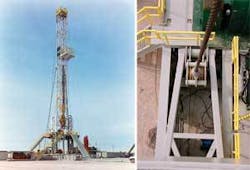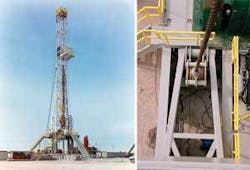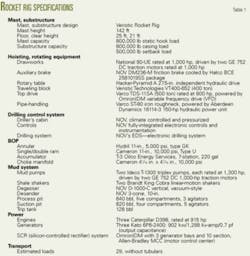A newly designed, fast moving, self-elevating land rig debuted in El Reno, Okla., in September 2006. The triple rig can be erected in about 20 min and drill to 18,000 ft. It features fully integrated electronic controls and instrumentation in a driller’s cabin from National Oilwell Varco.
Oklahoma’s Cactus Drilling Co. LLC has finished Rig. 136,the first of four Rocket rigs currently under construction, and plans to complete and deliver the remaining three by January 2007. The first and second 1,000-hp rigs will go to work by yearend under 3-year contracts for XTO Energy Inc.(Fig. 1) XTO will use them to drill the Barnett shale in Tarrant and Johnson counties, Tex. The third and fourth rigs, both 1,500 hp, will drill for Newfield Exploration Co. under 2-year contracts. Newfield will use the rigs near Coalgate, Coal County, Okla., to drill the Woodford shale with a contained mud system.
Mast erection
The mast and substructure were designed by Ted Vora, at Houston-based Veristic Technologies Inc (www.veristictech.com). The raising system is unique, differentiated from both the typical self-elevating system and the Dreco slingshot system, which raises both mast and drawworks.
The Rocket Rig system uses hydraulic winches to raise the mast and the entire drill floor assembly with equipment, all in one single shot. The drill floor stays horizontal throughout the procedure, following an arc-path from near the V-door (mast-down position) to the hole (mast-up).
The fully erect mast is hoisted hydraulically by two spooled cables (Fig. 2).
Cactus Drilling has set up the first Rocket Rig to skid for pad drilling. XTO will pad-drill on 10-ft centers, and the substructure of the Rocket Rig can move forward while leaving other equipment in place.
Features
The new rig can build triple stands offline using a rotating, 90-ft mousehole. It features hydraulic slips, a Varco ST-80 iron roughneck, and a Varco TDS-11SA top drive (Table 1).
The mud system features two, triplex Ideco pumps, rated 1,300-hp, and NOV degasser, desander, and desilter.
Cactus chose to incorporate a North Sea rig feature from Scottish company P-Quip Ltd.-a hydraulic retention system for pump liners and pump rods. This holds proper tension on the pit liners, instead of having use a nut and sledgehammer.
The Rocket Rig can move in about 29 loads, not including tubulars.
Cactus
Before adding the new Rocket Rigs, Cactus Drilling had 34 rigs in the fleet, operating in the Midcontinent, the Barnett shale, the Permian Basin, South Louisiana, North Louisiana (Ark-La-Tex), and the Texas Gulf Coast. The fleet’s depth capacity ranges 13,000-30,000 ft, 650-2,500 hp.
Cactus Drilling has about 900 employees and is closely held by Kaiser Francis Oil Co.
The rigs cost about $10 million each to build, and lease at a premium-about $3,000/day more than typical 1,000-hp land rigs-because of the integrated top drive, electronic drilling system, and reduced mobilization time.
Ron Tyson, manager at Cactus Drilling, told OGJ that the company has components or order for four more rigs, and would be willing to build more Rockets under contract if there is operator demand. “Everyone wants rigs that are automated and can move quickly.”



